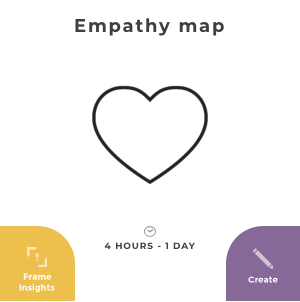2.4 Making Sense
2.4.2 Empathy Mapping
Using an empathy map is a way to swiftly make sense of your gathered data, such as from an interview. It is a method of visualization used to articulate what you learned. You categorize observations and data in such a way that you get an empathetic understanding of that person.
You categorize your learnings by considering what he or she sees and/or experiences, hears (what people are telling him or her), says and does, and what he or she thinks and feels. This last category requires interpretation. By going back and forth between categorizing what the persons sees, hears and says, you can induce what he or she might be thinking or feeling. Once you categorized the observations, you induce what the pains and gains are for this person. Pains are the problems that the person is experiencing and the gains concern his or her (often latent) needs.
With empathy maps you are making sense of individual interviews. It may only be possible to generate an aggregated empathy map for multiply users after developing a number of empathy maps. However, this needs to be done carefully because the interesting perspectives of individuals are often quite different. As a result, the aggregated empathy map may flatten out interesting, yet contesting pains and gains.
| Guido Stompff - Design research: Empathy maps |
Empathy maps are developed as part of generating a business model (Osterwalder et al., 2010) to gain empathy for your users. Terms such as pains and gains can be attributed to that specific method. Unfortunately, the popularity of business model canvases (and also empathy maps) resulted in a tendency to consider them as a means to facilitate a workshop. If you create empathy maps without doing interviews, the maps are a result of co-creation. This puts you at risk of developing persuasive arguments that are rooted in assumptions of workshop participants, instead of developing arguments based on solid data.
Imagine that you have to organize a dinner in a restaurant for 10 friends. How do you do that? Download a template for an empathy map (e.g. here) and map your seeing, hearing, saying and thinking. What things or websites do you inspect? What people will give you advice, and what will they say? What do you do and say? What are you thinking? And consequently, what are your pains and gains?
Learn more
An extensive guideline on making empathy maps in a team is offered here. Unfortunately, it is very brief and you must do user research before doing the workshop.
References
- Osterwalder, A., & Pigneur, Y. (2010). Business model generation: a handbook for visionaries, game changers, and challengers. John Wiley & Sons.


